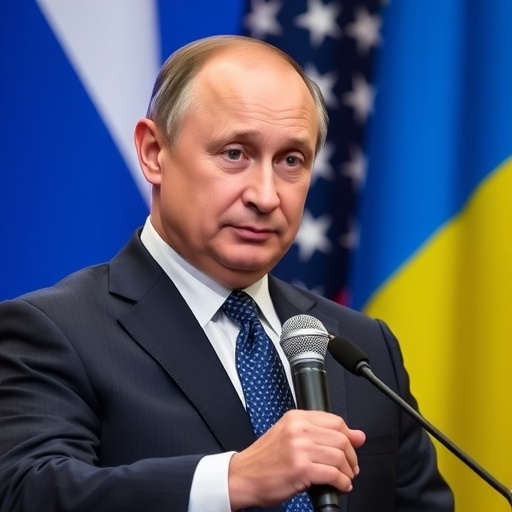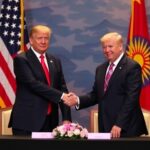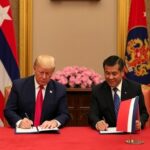Putin‘s Envoy Reveals Russia, US, and Ukraine on Brink of Diplomatic Solution to End Three-Year War
In a stunning development that could reshape the geopolitical landscape, Kirill Dmitriev, a key envoy for Russian President Vladimir Putin, has declared that Russia, the United States, and Ukraine are “quite close to a diplomatic solution” aimed at ending the protracted three-year war. This optimistic assessment comes amid ongoing high-stakes talks in Washington, D.C., where diplomats are reportedly making significant strides toward peace. The revelation, shared during a recent interview, injects fresh hope into a conflict that has claimed hundreds of thousands of lives and devastated economies worldwide.
- Dmitriev’s Washington Talks Signal Breakthrough Momentum
- Postponed Trump-Putin Summit Fuels Speculation on Peace Timeline
- Three Years of Devastation: The Human and Economic Cost Driving Diplomacy
- Global Reactions and Skepticism Temper Hopes for Swift Resolution
- Charting the Path Forward: Ceasefire Prospects and Long-Term Stability
Dmitriev’s comments mark a rare moment of positivity in the Russia-Ukraine war, which escalated in February 2022 with Russia’s full-scale invasion. As the conflict enters its fourth year, the involvement of U.S. President-elect Donald Trump—who has long advocated for a swift resolution—adds intrigue. A planned summit between Trump and Putin, initially postponed due to scheduling conflicts, is now eyed for later this year, potentially accelerating negotiations.
The envoy’s statement underscores a shift from battlefield stalemates to diplomatic maneuvering, with sources indicating that confidential discussions have covered territorial concessions, security guarantees, and reconstruction aid. While details remain scarce, the mere suggestion of progress has sparked global reactions, from cautious optimism in Kyiv to skepticism in Moscow’s corridors of power.
Dmitriev’s Washington Talks Signal Breakthrough Momentum
Kirill Dmitriev, a prominent financier and special representative for Putin on strategic projects, arrived in Washington last week for what insiders describe as “intensive and productive” meetings with U.S. officials. Speaking to reporters outside the State Department, Dmitriev emphasized the urgency of de-escalation, stating, “We are quite close to a diplomatic solution that respects the interests of all parties involved—Russia, the US, and Ukraine. The time for dialogue is now.”
These talks, which involved senior advisors from the incoming Trump administration, focused on core issues like the status of Crimea and the Donbas region, where fighting has been fiercest. According to a leaked diplomatic cable obtained by international news outlets, participants discussed a framework for a ceasefire that could include multinational peacekeeping forces. Dmitriev highlighted the role of economic incentives, noting Russia’s willingness to ease energy export restrictions in exchange for lifted sanctions.
Statistics paint a grim picture of the war’s toll, underscoring why a diplomatic solution is so desperately needed. The United Nations reports over 10,000 civilian deaths and the displacement of more than 6 million Ukrainians since 2022. On the economic front, Ukraine’s GDP has shrunk by 30%, while Russia’s military spending has ballooned to 6% of its GDP, straining both nations. U.S. aid to Ukraine alone exceeds $175 billion, a figure Trump has criticized as unsustainable.
Experts like Fiona Hill, former U.S. National Security Council official, praised the initiative in a CNN analysis: “Dmitriev’s outreach represents a pragmatic pivot for Putin, especially with Trump‘s return to the White House. If these talks yield even partial agreements, it could prevent further escalation.” However, Hill cautioned that trust remains low, with past Minsk agreements failing to deliver lasting peace.
Postponed Trump-Putin Summit Fuels Speculation on Peace Timeline
The shadow of a potential Trump–Putin summit looms large over the current diplomatic push. Originally slated for early December in neutral Vienna, the meeting was delayed after Trump cited “pressing domestic priorities” following his election victory. Yet, Dmitriev revealed that rescheduling efforts are underway, with possible venues including Riyadh or Istanbul—locations that have hosted previous Russia-Ukraine mediations.
Trump, who during his campaign promised to end the war “in 24 hours,” has reportedly been in indirect contact with Putin through backchannels. A source close to the transition team told Reuters, “The president-elect sees this as an opportunity to demonstrate his deal-making prowess on the world stage. A summit could lock in commitments that eluded the Biden administration.”
Historical precedents add weight to the speculation. The 2018 Helsinki summit between Trump and Putin produced vague accords on arms control, but critics argue it emboldened Russian aggression. This time, with Ukraine‘s future at stake, expectations are higher. Ukrainian President Volodymyr Zelenskyy, in a recent address to the European Parliament, expressed guarded optimism: “Any path to peace must prioritize our sovereignty. We’re open to talks if they lead to real security, not capitulation.”
Behind the scenes, logistical preparations are accelerating. Saudi Arabia, a key oil player, has offered to host, leveraging its neutral stance and economic ties to all parties. Analysts estimate that a successful summit could reduce global energy prices by 10-15%, as restored Russian gas flows to Europe alleviate current shortages. Yet, challenges persist: NATO allies worry that a rushed deal might undermine Ukraine‘s defenses, potentially inviting future incursions.
Three Years of Devastation: The Human and Economic Cost Driving Diplomacy
As envoys like Dmitriev push for a diplomatic solution, the war‘s devastating legacy serves as a stark reminder of the stakes. What began as a Russian bid to “denazify” Ukraine has morphed into a grinding attritional conflict, with frontlines barely moving since 2023. Russian forces control about 18% of Ukrainian territory, including Crimea annexed in 2014, but at a cost of an estimated 500,000 casualties on both sides, per British intelligence assessments.
In Ukraine, cities like Kharkiv and Mariupol bear the scars of relentless bombardment. A World Bank report details $486 billion in reconstruction needs, equivalent to Ukraine’s pre-war GDP. Families separated by the conflict number in the millions; stories like that of Olena Kovalenko, a Kyiv teacher who lost her home in a missile strike, humanize the crisis. “Every day without peace steals our future,” she shared in a BBC interview.
Russia faces its own burdens. Sanctions have isolated its economy, with inflation at 9% and a brain drain of over 1 million skilled workers. Putin‘s domestic support, once unassailable, shows cracks—polls indicate 40% of Russians favor negotiations over continued fighting. Internationally, the war has realigned alliances, boosting China’s influence while straining U.S.-European unity.
U.S. involvement, under both Biden and now Trump, has been pivotal. Over 50 countries have provided aid to Ukraine, but fatigue is setting in. A Pew Research survey found 55% of Americans now support diplomatic overtures, up from 40% in 2022. This shift pressures leaders to prioritize talks, potentially framing the diplomatic solution as a legacy-defining achievement for Trump.
Global Reactions and Skepticism Temper Hopes for Swift Resolution
Dmitriev’s proclamation has elicited a spectrum of responses, from enthusiasm in some quarters to outright doubt in others. In Kyiv, Foreign Minister Dmytro Kuleba welcomed the dialogue but stressed red lines: “Ukraine will not accept any deal that compromises our borders or democracy.” Zelenskyy’s team is preparing counter-proposals, including demands for war crimes accountability and demilitarization of Russian border regions.
European leaders, gathered at a Brussels summit, expressed mixed views. German Chancellor Olaf Scholz called it “a step forward,” while French President Emmanuel Macron urged caution, warning against “false dawns.” Poland, a staunch Ukraine supporter, has mobilized border defenses in anticipation of any agreement’s fallout.
In Moscow, state media portrays the talks as Putin‘s strategic masterstroke, downplaying concessions. Independent voices, like exiled oligarch Mikhail Khodorkovsky, are more critical: “This is Putin testing Trump‘s resolve. Without ironclad guarantees, it’s just theater.”
Broader implications ripple through global markets. Stock indices rose 2% following Dmitriev’s comments, with commodity traders betting on stabilized wheat and oil prices—essentials disrupted by the war. Humanitarian organizations, including the Red Cross, are ramping up readiness for potential ceasefires, aiming to deliver aid to besieged areas.
Security experts outline risks: A premature deal could embolden aggressors elsewhere, from Taiwan to the Middle East. Yet, proponents argue that sustained diplomacy might restore the post-Cold War order, with renewed focus on multilateral institutions like the UN.
Charting the Path Forward: Ceasefire Prospects and Long-Term Stability
Looking ahead, the trajectory toward a diplomatic solution hinges on several milestones. First, the rescheduled Trump–Putin summit could formalize interim measures, such as prisoner exchanges—over 10,000 captives remain in limbo—and humanitarian corridors. U.S. officials hint at a “phased approach,” starting with de-escalation in the Black Sea to safeguard grain exports, vital for global food security.
Long-term, a comprehensive treaty might involve NATO’s non-expansion pledges for Ukraine, coupled with Russian troop withdrawals. Economists project that peace could add $1 trillion to combined GDP growth over a decade, through trade normalization and investment influx. Initiatives like the EU’s Ukraine Facility, worth €50 billion, stand ready to support rebuilding.
Challenges abound: Hardliners in all camps could derail progress, and verification mechanisms—perhaps involving OSCE monitors—will be crucial. As Trump assumes office in January, his administration’s signals will be pivotal. Advisors like JD Vance have advocated for “realism over idealism,” suggesting a deal that balances deterrence with pragmatism.
Ultimately, the envoy’s words offer a glimmer of hope in a darkened arena. If Russia, the US, and Ukraine seize this moment, the war‘s end could herald a new era of stability, proving that even the most entrenched conflicts yield to determined diplomacy. Stakeholders worldwide watch closely, praying for breakthroughs that prioritize lives over lines on a map.









